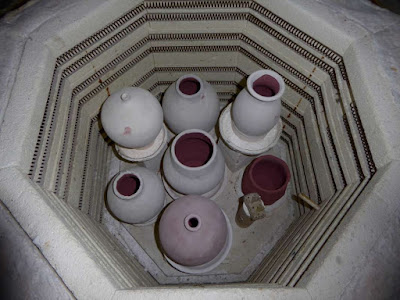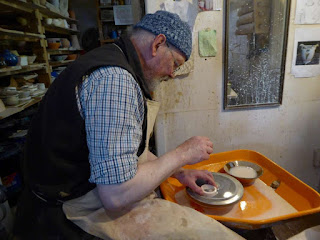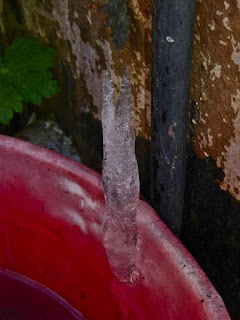Nearly ready for the Crystalline Glaze! Well almost! Rings, bowls and lots of alumina hydrate!
 |
| A puddle of crystalline glaze, safely caught in a glaze catching bowl. |
Macro crystalline glazes flow like treacle when the kiln is at very high temperature and will quietly ooze their way off the foot of the pot and form a large puddle on the kiln shelf if left to their own devices. For a glaze in which very large crystals are to be formed, this is entirely normal behavior, in almost every other glaze type, this would be regarded as very bad manners!
 |
| Pots and glaze catching bowls being readied for firing in the kiln. |
Every pot that I crystalline glaze has to sit on a little ring of clay in a glaze catching bowl.
I make batches of glaze catching bowls well ahead of time in what I hope will be useful sizes, and I also make the rings of clay in batches too.
Making Bowls
The bowls are usually around 5 or 6 inches (12.5 x 15 cm) in diameter and are made out of any strong high fired stoneware clay. I do also make a few larger and smaller bowls for pots that need them. The bowls are very simple in form, flat bottomed with sides turned up half and inch or so high. The bowls can be made on the wheel or in a press mould out of slab clay, what ever is easier. Making them on the wheel is good throwing practice, and some turn out so nicely that one or two escape their fate as glaze catchers, and get used domestically instead! The bowls are bisque fired then are thickly coated with kiln wash, or similar, to make it possible to chip the glaze out of them so the bowls can be reused a few times.
 |
| Glaze catching bowls. |
My most recent batch of glaze catching bowls were coated with the following preparation, that was all "weighed" by eye!
1 measure china clay
1 measure silica
2 measures alumina hydrate.
These were mixed together with water to a thick creamy consistency and applied to the bowls with a two and a half inch paint brush.
Making Rings
What works for me is to make a series of open ended cylinders on the wheel. The cylinders are made out of the same clay that the pots are made out of, and for crystalline glazing this will be porcelain or a fine white stoneware. The cylinders are generally about 5 or 6 inches high (12.5 x 15cm), and are wider at the base than the top. I try to keep the wall thickness as even as I can, about a quarter of an inch (6mm), and I finish it smooth with a wooden rib. After a few hours when the cylinders have dried to soft leather hard, I put them on the wheel again and use a needle tool (a wooden kebab stick) to cut them into rings. About five eights of an inch (1.5cm), seems to work quite well for height, but I just do what looks right rather than measure each one.
 |
| A box of rings. |
I mentioned that the cylinders are wider at the base than the top, this means that when they are cut into rings, they give a selection of sizes, and each ring can give two possible diameters, depending which way up it is.
The diameter of the ring has to be the same, or very slightly smaller, then the pot it is supporting, and it has to be a perfect fit with no gaps or wobbles! I wet grind the base of the pot and the ring with an abrasive disk to ensure a good fit.
 |
| Wet grinding the ring. |
 |
| Wet grinding the base of the pot. |
 |
| Checking the fit of ring and pot. |
The ring is glued to the pot with a mixture of thinned down PVA glue (wood glue), and alumina hydrate. Some potters use china clay instead of alumina hydrate. The glue burns away in the kiln leaving a thin layer of alumina between the ring and the base of the pot. The alumina acts as a release agent and makes it possible to remove the ring from the pot after the firing.
Some potters apply the ring to the foot of the pot after the pot has been glazed, and others put the ring on first. I do both! Most recently I glued the rings to the pots I had set aside for crystalline glazing before they were glazed. I had 20 pots to find rings for, and I didn't want to muddle the rings and pots up after I had matched each one.
I found the rings made glazing easier as they gave something more to hold onto whilst applying glaze to the pot.
 |
| Something to hold onto when glazing. |
 |
| Glaze brushed on very thickly. |
More about glazing next time, but this will do for now!


Comments
Now, if those rings were chocolate doughnuts... that would be interesting! ...Apologies, tea time here and my mind, such as it is, has pleasant anticipatory thoughts of food floating through it!
Good to hear from you Charlie. I have been thinking of you up in Auckland and wondering how things are. I have enjoyed making things on the wheel, but the "tricky" glazing, really is... and has many frustrations as well as the occasional ray of sunshine! I may be tempted to throw together some ash glazes soon and bung some pots in the wood fired kiln! It would be quite therapeutic.
Very nice to hear from you. Glad that you are OK. Interesting how the lockdown can actually inspire creativity, I do find the peace and quiet and lack of interruptions rather conducive to trying new things. Good that you are coming up with new designs and have actually had a sale (I'm tempted to say a "sail" seeing as there was a yacht involved!).
Laura has done some really splendid studies of sunflowers. Amazingly detailed, but very lively, drawings. As usual they have spread larger than the paper that she started on, so would be a bit of a challenge to frame..., but real progress. I will leave some huge sheets of rather good paper around near her work table and see if she will make use of those! :-)
All the very best from us down here,
Peter & Laura